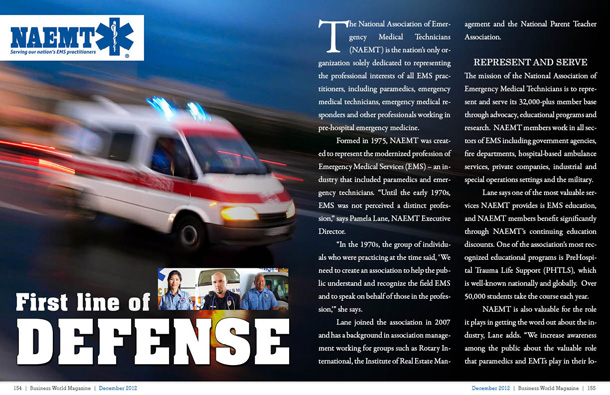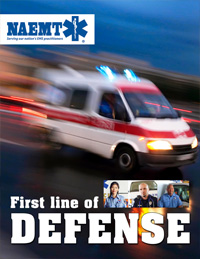

The National Association of Emergency Medical Technicians (NAEMT) is the nation’s only organization solely dedicated to representing the professional interests of all EMS practitioners, including paramedics, emergency medical technicians, emergency medical responders and other professionals working in pre-hospital emergency medicine.
Formed in 1975, NAEMT was created to represent the modernized profession of Emergency Medical Services (EMS) – an industry that included paramedics and emergency technicians. “Until the early 1970s, EMS was not perceived a distinct profession,†says Pamela Lane, NAEMT Executive Director.
“In the 1970s, the group of individuals who were practicing at the time said, ‘We need to create an association to help the public understand and recognize the field EMS and to speak on behalf of those in the profession,’†she says.
Lane joined the association in 2007 and has a background in association management working for groups such as Rotary International, the Institute of Real Estate Management and the National Parent Teacher Association.
Represent and serve
The mission of the National Association of Emergency Medical Technicians is to represent and serve its 32,000-plus member base through advocacy, educational programs and research. NAEMT members work in all sectors of EMS including government agencies, fire departments, hospital-based ambulance services, private companies, industrial and special operations settings and the military.
Lane says one of the most valuable services NAEMT provides is EMS education, and NAEMT members benefit significantly through NAEMT’s continuing education discounts. One of the association’s most recognized educational programs is PreHospital Trauma Life Support (PHTLS), which is well-known nationally and globally. Over 50,000 students take the course each year.
NAEMT is also valuable for the role it plays in getting the word out about the industry, Lane adds. “We increase awareness among the public about the valuable role that paramedics and EMTs play in their local communities and as part of the national public safety network.â€
“It helps not only the public understand, but helps give a sense of pride and professionalism to those who practice EMS,†she explains. “To further support these professionals, we have a really strong package of member benefits that address the specific needs of paramedics and EMTs.â€
Another primary role of the National Association of Emergency Medical Technicians is to advocate to the national government on their members’ behalf with regards to legislation and regulation affecting EMS and EMS practitioners.
One of the association’s strategic goals is to build and foster relationships with key departments within the federal government that have jurisdiction over EMS. For example, NAEMT has built a strong relationship with the U.S. Department of Homeland Security (DHS) – including the Federal Emergency Management Agency (FEMA) – since EMS is a critical part of the national public safety network.
“In times of natural or man-made disasters, EMS is an important component of that public safety net,†Lane says. “We build those relationships and we work with those agencies to make sure the regulations that they’re establishing or revising make sense.â€
The association also works actively with members of the U.S. Congress on legislation critical to NAEMT members. Two of the bills they’re focused on currently are the Medicare Ambulance Access Preservation Act of 2011 and the Veterans to Paramedics Transition Act. “When military medics return to civilian life, they need to either get re-licensed in EMS or they need to become licensed,†Lane explains. “They have all the skills, but aren’t licensed at the state level.â€
The third major piece of legislation of concern to NAEMT at the moment, according to Lane, is the Field EMS Quality, Innovation, and Cost Effectiveness Improvements Act of 2011. “This bill includes funding for local EMS agencies so they can hire, train and equip their EMS practitioners to serve their community to achieve surge capacity in the event of a disaster.â€
Last year NAEMT collaborated with other national public safety organizations to ensure that Congress allocates a portion of the public broadband spectrum to public safety. Lane referred to Hurricane Katrina as an example where a lack of broadband frequency hindered communications between state emergency managers, EMS, the fire service and law enforcement.
“Consideration had been given to selling this section of the broadband spectrum to the private sector to expand commercial broadband networks, but we were successful in having it allocated to public safety,†she says. “With the passage of that legislation, a new national board has been established to implement a national public safety communications network.â€
EMS on the Hill Day
On March 5 and 6, 2013, in Washington, D.C., the National Association of Emergency Medical Technicians will be holding their annual EMS on the Hill Day event – inviting EMS practitioners nationwide to gather at Capitol Hill to discuss industry issues with their congressional leaders. The projected number of people expected to attend that event is getting increasing h each year, Lane says. “People in our profession recognize that we need to be visible. The people in Congress, as representatives of the House and Senate, work for us.â€
“The only way they’re going to really understand what we need is to sit down and talk about it with them,†she adds.
Going forward, retaining and increasing their membership remains a top priority for NAEMT. By the end of 2014, the plan for the association is to recruit and retain well over 10,000 full-time EMS members, as well as “raise the bar on education for paramedics and EMTs,†Lane says.
Another key focus for NAEMT will be Community Paramedicine – an organized system of services based on local need that is provided by EMTs and paramedics, which is integrated into local or regional health care. “Hospitals and medical systems are looking at innovative ways to improve patient care and efficiency in the health care system by utilizing paramedics to reach out into the community to provide primary medical care beyond the hospital,†Lane says.






